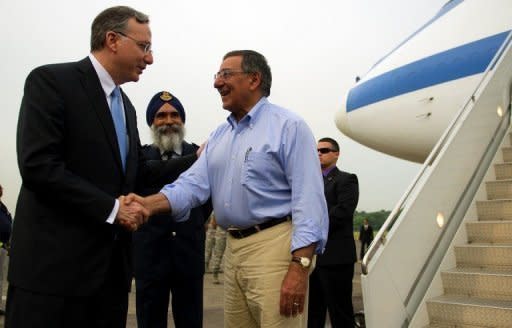US sees strategic role for Vietnam's southern port
US Defense Secretary Leon Panetta said Sunday a former port used by US forces in the Vietnam War could play a pivotal role in the American military's shift towards the Asia-Pacific. Panetta's visit to Cam Ranh Bay was the first by a Pentagon chief since the end of the Vietnam War in 1975, and the highly symbolic trip reflected Washington's efforts to deepen ties with its former enemy as it seeks to counter China's growing power. "Access for US naval ships into this facility is a key component of this relationship and we see a tremendous potential here," he told reporters on the deck of the USNS Richard E. Byrd, an American naval cargo ship currently at the port. With new plans to shift the majority of the US naval fleet to the Pacific by 2020, Panetta described the deep-water harbour as strategically vital. "It will be particularly important to be able to work with partners like Vietnam, to be able to use harbours like this, as we move our ships from our ports on the West Coast, (and) our stations here in the Pacific," he said. Cam Rahn Bay is one the region's best natural harbours and the United States sees it an ideal spot to bolster an American naval presence in the contested South China Sea. Vietnam recently started allowing foreign navies, including the United States, to use Cam Rahn Bay to resupply and undergo repairs. But the number of visits per year is restricted, and US commanders would like to have expanded access to the harbour, possibly including warships, analysts say. Panetta's trip reflected the transformation of US relations with Vietnam as well as a growing rivalry between China and the United States, with the South China Sea at the centre of the competition. Looking out on a bay that was once teeming with US naval ships during the peak of the Vietnam war, Panetta spoke of the "arc of history" in which a bitter war had given way to a new era. "For me personally, this is a very emotional moment," he said. The Pentagon chief said "a great deal of blood was spilled in this war on all sides," but he hoped that "out of all of that sacrifice, we can build a strong partnership between both of our countries that looks to the future." The two countries signed a memorandum on defence cooperation last year and Panetta will meet with high ranking Vietnamese officials, including the defence minister, in Hanoi during his two-day visit to discuss how to fulfil the agreement. "We've come a long way, particularly with regards to our defence relationship," he said in the blazing sunshine on deck, adding that now he wanted "to take this relationship to the next level." Cam Ranh Bay was one of three main hubs used by US forces in the war. The Vietnamese later leased the area to the Soviet Union, which used it during the Cold War, but the Russians left the base in 2002. The Pentagon's plan to send more ships to the Pacific, unveiled Saturday during a speech by Panetta at a security summit in Singapore, reflects US concern over China's rising economic and military might. But Panetta insisted the strategy was not a challenge to Beijing. China claims all of the South China Sea, which is believed to encompass huge oil and gas reserves. One-third of global seaborne trade passes through the region. Panetta, who is on a nine-day regional tour, also said the US wants to work with Vietnam on "maritime issues," including on a code of conduct for all nations using the South China Sea, and on improving "freedom of navigation in our oceans." Hanoi and Beijing, which have rival claims to the Spratly Islands and a long-standing dispute over the Paracel island group, have frequent diplomatic spats over fishing rights and oil exploration in the area. Analysts say a more aggressive approach from China in the South China Sea has prompted Vietnam to forge closer defence cooperation with its former foe the United States.



